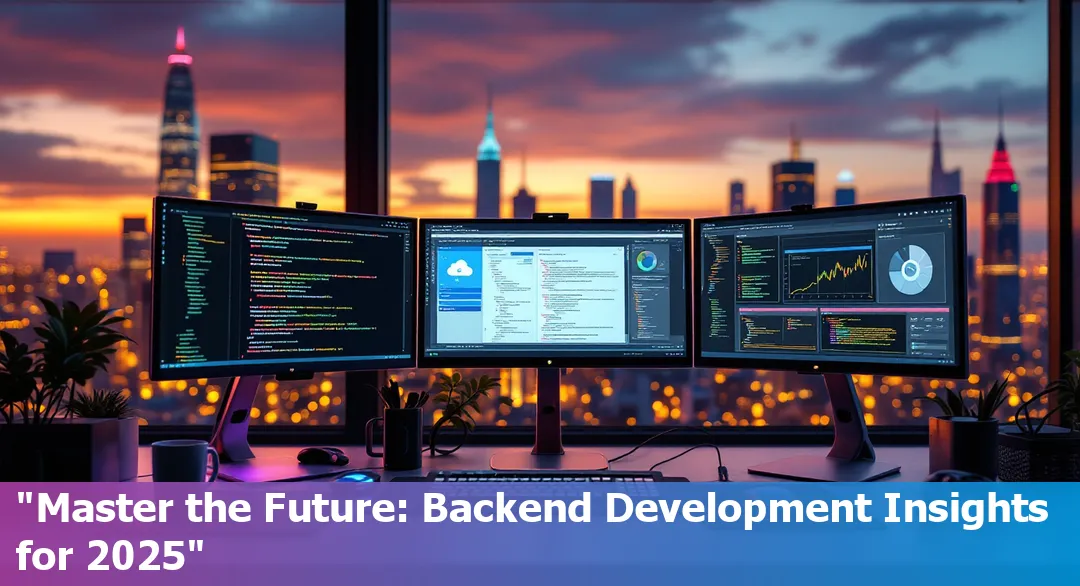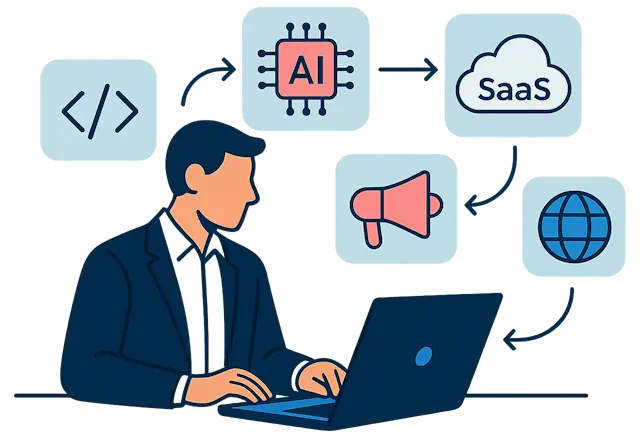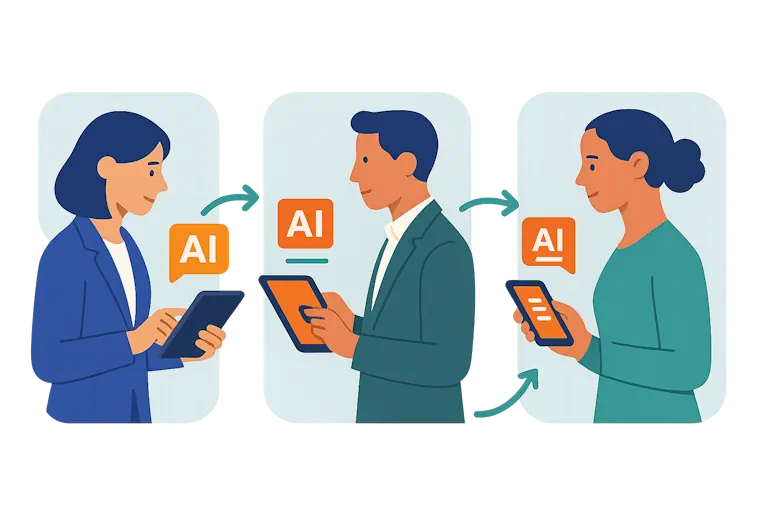The Ultimate Guide to Backend Development in 2025: Trends, Tools, and Techniques for Python, SQL, DevOps, and Cloud Services
Last Updated: February 14th 2025

Too Long; Didn't Read:
In 2025, backend development is rapidly evolving with microservices, serverless computing, AI, and cloud services like AWS, Azure, and Google Cloud leading the charge. Python remains the dominant programming language, essential for roles demanding cloud computing and API skills, as industry salaries exceed $114,000. DevOps practices emphasize containerization and automation, enhancing operational efficiency. The global cloud services market, valued at $313 billion, evidences robust growth, making backend expertise in scalable, secure, and efficient systems indispensable for careers in this dynamic field.
In 2025, backend development is absolutely crushing it as the backbone of modern tech, powering everything from social media to streaming services we can't live without.
The backend development landscape is transforming rapidly with microservices architecture and serverless computing leading the charge.
As someone diving into this field, it's wild to see how emerging technologies like AI and machine learning are becoming standard in backend systems, making applications smarter and more efficient.
The real game-changer is how cloud services and DevOps practices are revolutionizing the way we build and deploy applications.
If you're starting out, focus on mastering Python and getting comfortable with frameworks like Django - trust me, these skills are gold right now. The job market is absolutely booming, with salaries growing faster than ever, especially if you've got skills in cloud computing and API development.
Whether you're building the next big social platform or working on enterprise solutions, backend development in 2025 is all about creating scalable, secure, and smart systems that can handle whatever users throw at them.
Get ready to explore the essential skills and tools that'll make you a backend powerhouse.
Table of Contents
- Key Trends Shaping Backend Development
- Essential Skills for Backend Developers
- Backend Development Roadmap for Beginners
- Importance of Cloud Services in Backend Development
- The Rise of AI and ML in Backend Systems
- Top Programming Languages and Frameworks
- DevOps Practices for Backend Efficiency
- Career Prospects in Backend Development
- Conclusion: Navigating the Future of Backend Development
- Frequently Asked Questions
- Master backend development with Python, SQL, and DevOps in Nucamp's Backend Development Bootcamp.
Key Trends Shaping Backend Development
(Up)Backend development in 2025 is experiencing massive changes, driven by some incredible advances in cloud technology and AI. According to recent market analysis, the global cloud services market has hit $313 billion, with AWS leading at 31% market share, followed by Azure at 20% and Google Cloud at 13%.
The shift to cloud-native development is real - I'm seeing it everywhere in my coding projects. These platforms are making it so much easier to build and scale applications without worrying about hardware limitations.
What's really interesting is how cloud-based AI is transforming backend development.
Machine learning operations are becoming more accessible through user-friendly tools and low-code platforms, which is perfect for developers like me who are just starting their careers.
The integration of AI isn't just a fancy add-on anymore - it's becoming essential for handling everything from data analytics to security.
Speaking of security, the latest trends show that cloud providers are stepping up their game with advanced security measures.
We're talking about data encryption that works even while the data is being used, which is pretty mind-blowing. The rise of industry-specific cloud platforms is another game-changer - they're expected to grow to $266.4 billion by the end of 2025.
As someone starting in this field, it's exciting to see how these specialized solutions are making it easier to build secure, compliant applications for specific sectors like healthcare and finance.
Essential Skills for Backend Developers
(Up)Backend development in 2025 has evolved into something pretty exciting, with Python leading the charge as a must-have skill. Python's versatility makes it perfect for everything from data analysis to machine learning, and it's becoming more valuable across different industries.
The language is super approachable for beginners while still being powerful enough for complex projects. What makes Python really stand out is how it helps developers solve tough problems quickly and efficiently.
When it comes to frameworks, Django and Spring Boot are running neck and neck in popularity.
Django is great for those starting out with Python, while Spring Boot shines in building microservices. The cool thing about Django is how it handles a lot of the complex stuff behind the scenes, letting developers focus on creating actual features.
According to recent surveys, both frameworks are equally popular on Stack Overflow, showing there's room for both in the industry.
The backend landscape keeps getting more diverse, with frameworks offering different advantages for different projects.
What's really interesting is how Python fits into all of this - it's not just about coding anymore, but about creating efficient, scalable solutions.
Whether you're building APIs, handling databases, or working on machine learning projects, Python's extensive library ecosystem makes it possible to tackle pretty much any challenge.
The best part? The community is super active and always ready to help, making it easier to learn and grow as a developer.
Backend Development Roadmap for Beginners
(Up)Starting a career in backend development in 2025 means getting comfortable with both fundamental concepts and cutting-edge tech. Backend development has evolved beyond basic coding, requiring a strategic approach to learning.
The essentials start with mastering a server-side programming language - Python is particularly great for beginners due to its clean syntax and powerful libraries.
Database management is another critical skill, whether working with SQL databases like PostgreSQL or NoSQL options like MongoDB.
One of the most exciting aspects is working with APIs and modern security protocols.
The latest API development practices in 2025 emphasize OAuth 2.1 and JWT for robust security.
Understanding these protocols isn't just about following best practices - it's about building systems that users can trust. Version control with Git remains essential, and knowing how to handle merge conflicts and maintain clean commit histories will save countless headaches down the line.
Entry-level backend developers need to focus on strong programming fundamentals while gradually building expertise in frameworks like Django or Flask.
Cloud services are becoming increasingly important, with platforms like AWS and Azure offering powerful tools for deployment and scaling. Testing is another crucial skill - writing good unit tests and understanding integration testing can make the difference between a reliable application and a buggy mess.
Key Takeaways:
- Master server-side programming languages: Start with languages like Python to develop clean and efficient server-side solutions.
- Develop strong database management skills: Gain proficiency in SQL and NoSQL to effectively manage and utilize databases.
- Understand modern APIs and security protocols: Learn API development practices and security protocols like OAuth 2.1 and JWT to secure user data.
- Practice version control with Git: Efficiently handle merge conflicts and maintain clean commit histories to streamline development workflows.
- Build proficiency in cloud services: Explore platforms like AWS and Azure to enhance deployment and scaling capabilities.
- Invest in testing skills: Create robust unit and integration tests to ensure application reliability and quality.
Importance of Cloud Services in Backend Development
(Up)Cloud services are absolutely crushing it in 2025, and AWS is leading the pack with its game-changing serverless computing solutions.
The cloud infrastructure scene is seriously impressive - AWS just announced they're expanding into new regions including Thailand and Mexico, investing billions to make their services even faster and more accessible.
What's really cool is how AWS is powering up their AI game with new models like Nova that are 75% cheaper than competitors, making it easier for developers to build smart applications without breaking the bank.
AWS holds a solid 32% market share, and they're not slowing down with constant updates to services like Amazon SageMaker and enhanced security tools.
The best part? They're planning to run on 100% renewable energy by 2025, which is seriously important for our future. Meanwhile, tools like AWS Lambda and Azure Functions are changing how we think about backend development - no more stressing about server management or scaling issues.
For real, it's amazing how we can just focus on writing code and let the cloud handle all the heavy lifting. Whether you're building a small app or scaling up a massive platform, these cloud services have got your back with automatic scaling, top-tier security, and infrastructure that just works.
Plus, with the rise of AI integration and green computing, we're looking at a future where backend development is not just more efficient, but also more sustainable.
It's pretty much impossible to imagine modern backend development without these cloud services - they're completely essential to building reliable, scalable applications in 2025.
The Rise of AI and ML in Backend Systems
(Up)The integration of AI and ML in backend systems has completely transformed how we build and maintain applications in 2025. AI is revolutionizing backend development by automating everything from code reviews to testing, making development workflows way more efficient than before.
What's really cool is how hyperautomation is taking over, connecting all these automated functions end-to-end and scaling them across entire organizations.
The results are pretty impressive - companies using AI-powered automation are seeing their operational costs drop by 12% over five years. Plus, these systems are getting super smart at handling complex stuff like compliance monitoring and fraud detection that used to be a huge headache for developers.
The backend development scene is getting a major upgrade with AI-driven enterprise solutions that can handle everything from data processing to real-time analytics.
Cloud platforms are making it easier than ever to implement these technologies, with tools that can predict server loads, manage resources automatically, and spot potential issues before they become problems.
We're seeing a 60% reduction in system downtimes compared to old-school methods, which is honestly mind-blowing. The best part? These AI systems are constantly learning and improving themselves, making backend operations more reliable and secure than ever.
For those of us just starting in backend development, it's crucial to get comfortable with AI and ML concepts early on.
The job market is definitely heading in this direction, with 75% of companies planning to increase their AI investments. While the learning curve might seem steep at first, starting with Python basics and gradually moving into AI frameworks like TensorFlow or PyTorch is totally doable.
The key is to focus on practical applications and real-world problems rather than getting lost in the theoretical stuff. Trust me, once you get the hang of it, implementing AI in backend systems becomes second nature.
Top Programming Languages and Frameworks
(Up)Backend development in 2025 is all about picking the right tools and languages to build powerful, scalable systems. According to recent studies, the top backend frameworks include Laravel, Django, and Spring Boot, each bringing unique advantages to the table.
Python continues to dominate, with its clean syntax and versatile frameworks making it the go-to choice for 75% of backend developers. Node.js remains super popular too, especially for real-time applications and microservices, powering major platforms like Netflix and Uber.
The latest trends show that Go and Rust are gaining serious momentum in 2025, particularly for performance-critical applications.
Go's simplicity and built-in concurrency features make it perfect for cloud-native development, while Rust's focus on memory safety has caught the attention of systems developers.
JavaScript maintains its position as a full-stack powerhouse, with frameworks like Express.js and NestJS making backend development more accessible than ever.
Speaking of frameworks, Django and Laravel lead the pack in 2025, offering robust features for rapid development.
Flask's lightweight approach makes it ideal for microservices, while Spring Boot dominates the enterprise space. The key is picking a stack that matches your project needs - Python for data-heavy applications, Node.js for real-time features, or Go for high-performance systems.
What's really cool is how these technologies are evolving to handle modern challenges like AI integration and cloud scaling, making it an exciting time to dive into backend development.
DevOps Practices for Backend Efficiency
(Up)The year 2025 marks a transformative period in backend development, with modern DevOps practices revolutionizing how we build and deploy applications.
Docker continues to be the go-to platform for containerization, making it super easy to package and run applications consistently across different environments.
What's really cool is that containerization is now mainstream - recent data shows more than 80% of companies worldwide are using containers in production. GitOps and cloud-native practices have become essential components of modern infrastructure management, especially when working with Kubernetes for orchestrating containerized applications.
CI/CD pipelines are absolutely crucial for keeping the development process smooth and efficient.
Tools like Jenkins, GitHub Actions, and GitLab CI have gotten even better at catching bugs early and pushing updates faster. The integration of AI into DevOps workflows is a game-changer - it's now helping teams predict potential failures and optimize deployment processes automatically.
Platform engineering has taken center stage, providing developers with everything they need in one place.
This has made it way easier to maintain consistent development environments and speed up the deployment pipeline.
The real power of DevOps comes from how it brings development and operations teams together.
As someone just starting in backend development, it's important to understand that DevOps is more than just tools - it's about working smarter and automating everything possible.
The stats are impressive: teams using DevOps deploy code 200 times more frequently and fix problems 80% faster than traditional setups. Plus, the shift toward cloud-native architectures means we're seeing more integration between container technologies, microservices, and automated testing frameworks.
Looking ahead, success in backend development requires getting comfortable with these DevOps practices and tools.
Companies are investing heavily in DevOps talent, and mastering these skills opens up tons of opportunities. The focus is increasingly on automation, observability, and creating systems that can scale efficiently.
Whether you're building small applications or enterprise-level systems, understanding these DevOps principles is key to becoming a successful backend developer in 2025.
Career Prospects in Backend Development
(Up)As a backend developer in 2025, I'm excited to share that the career prospects are seriously impressive. According to recent salary data, backend developers in the US are earning an average of $114,000 base salary, with additional compensation like bonuses and profit-sharing pushing total earnings up by around $24,000.
The job market is growing steadily, with an 8% projected growth rate through 2033. Cloud computing skills have become absolutely essential—programming, security, and database management are the top requirements.
The shift towards cloud platforms has totally changed how we build and scale applications.
Something that gets me pumped about this field is the salary progression.
Latest market analysis shows that entry-level positions start around $90,000, and you can hit $115,000+ as a senior developer.
The coolest part? Companies are now focusing more on skills than degrees—70% have switched to skills-based hiring. This means if you're good at what you do, you don't necessarily need a fancy degree to land an awesome job.
What matters more is staying current with technologies like the MERN stack (MongoDB, Express.js, React, Node.js) and getting comfortable with AI tools in development.
Remote work opportunities are also making this career path even more attractive.
Around 44% of backend developer positions are remote, giving us the flexibility to work from anywhere while collaborating on global projects.
The demand is especially high in sectors like Information Technology, where average salaries reach $136,354, and Media & Communication at $110,527. For someone starting their career today, the combination of strong technical skills, particularly in cloud computing and AI, along with the ability to work in remote teams, creates an incredible foundation for long-term success in this field.
Conclusion: Navigating the Future of Backend Development
(Up)Looking ahead to backend development in 2025, it's mind-blowing how fast everything's changing. Backend as a Service (BaaS) and serverless computing are totally reshaping how we build applications.
The coolest part? Python's still crushing it as the go-to language for backend development, especially with its AI capabilities and simple syntax. According to pros like David Lopez at CloudThat, its massive library support makes it perfect for both newbies and veterans.
What's really exciting is how AI-powered development tools are changing the game.
They're cutting development time in half and making coding more accessible than ever. Low-code platforms are exploding too - by 2025, they're expected to handle over 70% of new enterprise apps.
That's huge for anyone getting into backend development right now!
The most important thing I've learned from staying on top of industry trends is that continuous learning isn't just nice to have - it's absolutely essential.
Backend developers need to keep upgrading their skills in cloud computing, DevOps, and security. With cyber threats getting more sophisticated, understanding security protocols isn't optional anymore.
The good news? There's never been a better time to jump into backend development. The field is growing like crazy, especially if you're into cloud services and AI integration.
Just remember to stay curious and keep learning - this field never stands still!
Frequently Asked Questions
(Up)What are the key trends in backend development for 2025?
Key trends in backend development for 2025 include the dominance of microservices architecture and serverless computing, accelerated growth in cloud services, significant AI integration, and a focus on security with advanced measures and industry-specific platforms.
What essential skills should backend developers focus on in 2025?
Backend developers in 2025 should focus on mastering server-side programming languages like Python, database management with both SQL and NoSQL, modern API and security protocols, version control with Git, cloud services, and testing skills for robust application development.
How important are cloud services in backend development by 2025?
Cloud services are crucial in 2025, providing game-changing serverless computing solutions, enhanced security, and scalability. AWS, Azure, and Google Cloud are leading platforms that facilitate building, deploying, and scaling applications efficiently.
What role do AI and ML play in backend systems in 2025?
AI and ML are deeply integrated into backend systems by 2025, automating processes like code reviews and testing, thus enhancing efficiency. They are essential for data processing, real-time analytics, and reducing system downtimes with predictive capabilities.
What are the career prospects for backend developers in 2025?
Backend developers in 2025 have impressive career prospects with an average salary of $114,000 in the US, and a growing job market. Key skills in cloud computing, security, and database management are in demand, with a strong shift towards skills-based hiring and remote work opportunities.
Understand the role of Python in enhancing API backends using AWS Lambda.
Uncover the power of Apache Kafka in facilitating efficient event handling and processing.
Discover the role of enhanced libraries like TensorFlow and PyTorch in driving the next wave of machine learning applications in DevOps.
Among the significant hurdles ahead, organizations face data overload challenges as they navigate vast telemetry data in increasingly complex environments.
Compare the performance and security features of PostgreSQL and MySQL to determine the best fit for your project.
Learn why AI-assisted data pipelines are becoming a game-changer in the data engineering sector.
Understand the significant importance of modernization for maintaining competitive advantage in 2025.
See how Comparing Reflex and FastAPI reveals crucial differences in ORM application scenarios.
Ludo Fourrage
Founder and CEO
Ludovic (Ludo) Fourrage is an education industry veteran, named in 2017 as a Learning Technology Leader by Training Magazine. Before founding Nucamp, Ludo spent 18 years at Microsoft where he led innovation in the learning space. As the Senior Director of Digital Learning at this same company, Ludo led the development of the first of its kind 'YouTube for the Enterprise'. More recently, he delivered one of the most successful Corporate MOOC programs in partnership with top business schools and consulting organizations, i.e. INSEAD, Wharton, London Business School, and Accenture, to name a few. With the belief that the right education for everyone is an achievable goal, Ludo leads the nucamp team in the quest to make quality education accessible


